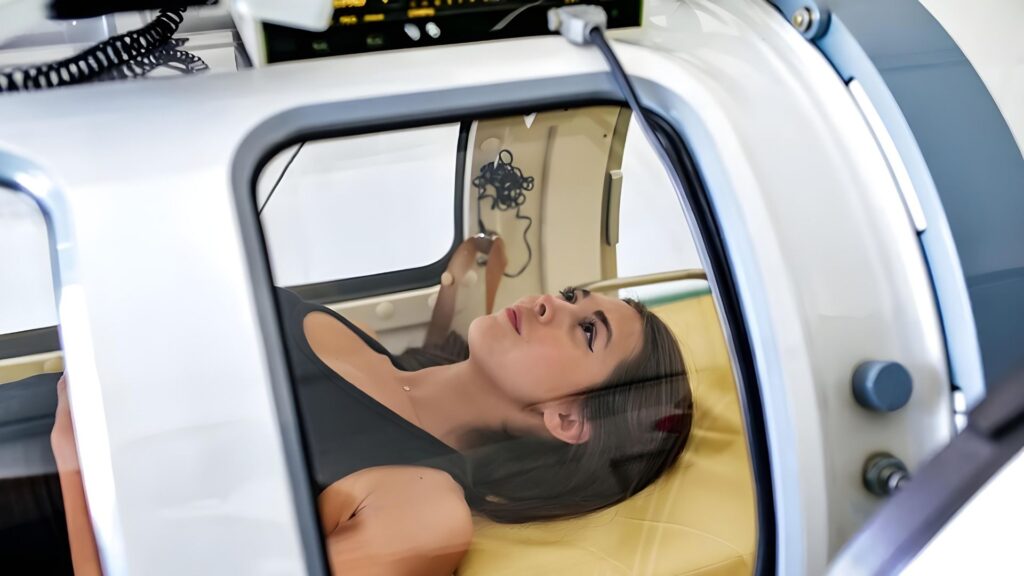Hyperbaric oxygen therapy (HBOT) involves breathing pure oxygen in a pressurized chamber to boost the amount of oxygen in the blood. This enhanced oxygen delivery supports healing and helps combat infection in oxygen-deprived tissues. HBOT is used to treat conditions ranging from carbon monoxide poisoning to chronic wounds like diabetic ulcers.
This article will explain how HBOT works, explore the conditions it treats, and highlight the potential benefits and safety considerations of this advanced medical therapy.

The Science Behind Hyperbaric Oxygen Therapy
HBOT works by placing patients in a hyperbaric oxygen therapy chamber. Inside the chamber, the air pressure is increased to about two to three times normal atmospheric pressure. Under these conditions, patients breathe 100% oxygen for about 60 to 90 minutes, significantly increasing the oxygen levels in their blood and tissues.
This increase in pressure follows Boyle’s Law and Henry’s Law, which explain how gases behave under pressure. The pressure in the chamber increases the amount of oxygen dissolved in the plasma, allowing oxygen to reach areas where blood flow is reduced or blocked.
This hyperoxygenation supports cellular metabolism and repair, even in tissues with damaged or compromised blood vessels.
How Hyperbaric Oxygen Therapy Works
There are two main types of hyperbaric chambers used in hyperbaric oxygen treatment. Monoplace chambers are designed for one person and are filled entirely with pure oxygen. In contrast, multiplace chambers can accommodate several individuals at once. These are pressurized with air, and patients breathe pure oxygen through masks or hoods.
HBOT produces two primary therapeutic effects. First, hyperoxygenation increases the oxygen concentration in blood plasma, allowing it to penetrate deeper into damaged or infected tissues, enhancing healing and reducing inflammation. Second, for conditions like decompression sickness or arterial gas embolism, the increased pressure in hyperbaric treatment helps reduce the size of gas bubbles in the bloodstream, relieving symptoms and preventing further complications.
Medical Conditions Treated with HBOT
Because of the effectiveness of hyperbaric oxygen therapy, HBOT has been approved by the United States Food and Drug Administration. Hyperbaric oxygen therapy helps treat several serious conditions, including:
- Carbon monoxide poisoning: HBOT rapidly removes carbon monoxide from hemoglobin, restoring oxygen delivery.
- Decompression sickness: Common in divers, HBOT reduces nitrogen bubbles in the blood.
- Arterial gas embolism: HBOT helps dissolve air bubbles blocking blood flow.
- Chronic wounds: Especially diabetic foot ulcers, where poor circulation impairs healing.
- Radiation therapy injuries: HBOT treats late radiation tissue injury by promoting new blood vessel growth.
- Severe infections: Such as necrotizing soft tissue infections and refractory osteomyelitis.
- Crush injuries and burns: HBOT reduces swelling and supports tissue repair.
- Skin grafts and flaps at risk of failure.
Beyond these, HBOT is being explored for neurological conditions and brain injuries due to its potential to reduce inflammation and promote neuroplasticity.
Physiological and Therapeutic Benefits
HBOT enhances oxygen delivery to tissues with poor blood flow, helping oxygen reach areas that are typically deprived due to injury or illness.
HBOT also reduces swelling and inflammation by causing vasoconstriction (narrowing of blood vessels) without compromising oxygen supply. This effect helps minimize tissue damage and pain while still delivering adequate oxygen.
Another key benefit is the stimulation of angiogenesis, or the formation of new blood vessels. This process is vital for wound care and healing, as well as long-term tissue regeneration, particularly in chronic wounds.
The therapy also promotes fibroblast activity and collagen synthesis, two essential components of tissue repair. Fibroblasts are responsible for building the structural framework of healing tissues, while collagen strengthens and stabilizes those structures.
HBOT supports the immune system by enhancing the ability of white blood cells, specifically leukocytes, to kill bacteria through oxidative mechanisms. It also boosts the effectiveness of antibiotics, creating a synergistic effect that improves infection control.
Finally, HBOT can reduce oxidative stress and modulate the body’s inflammatory response, helping restore balance at the cellular level. Together, these effects contribute to faster healing, improved tissue regeneration, and better overall health outcomes.

Safety and Considerations
HBOT is generally safe and well-tolerated, but like any therapy, it can have potential side effects, including mild ear discomfort, sinus pain, or temporary vision changes. Rarely, oxygen toxicity may occur if oxygen levels are too high for prolonged periods.
Certain conditions, such as severe congestive heart failure or untreated pneumothorax, are contraindications for HBOT. Patients are carefully evaluated and monitored during therapy to minimize risks.
Preparing for Hyperbaric Oxygen Therapy
Before receiving Hyperbaric Oxygen Therapy (HBOT), patients should carefully follow specific guidelines provided by their healthcare provider to ensure safety and maximize treatment effectiveness. This includes wearing comfortable, loose-fitting clothing without any metal components, such as zippers or buttons, as metal can interfere with the chamber environment.
Patients are also advised to avoid applying lotions, oils, perfumes, or any flammable substances on their skin before the session to reduce the risk of fire hazards inside the oxygen-rich chamber. Additionally, patients should inform their provider of any medical conditions, medications, or recent surgeries, as these factors can influence treatment protocols.
The total number of treatments varies widely depending on the condition being treated, ranging from a few sessions for minor injuries or infections to 20 or more for chronic conditions such as non-healing wounds, radiation injuries, or neurological disorders. Healthcare providers tailor the treatment plan based on individual needs, monitoring progress, and adjusting the number and duration of sessions accordingly to optimize healing outcomes.
Final Thoughts from Quantum Wellness Center
Hyperbaric oxygen therapy is a powerful, non-invasive treatment that increases the amount of oxygen in the blood and tissues, thereby promoting healing and combating infections. Delivered in a hyperbaric chamber under increased air pressure, HBOT treats a variety of conditions from carbon monoxide poisoning to chronic wounds like diabetic foot ulcers, and supports overall wound healing and tissue repair.
At Quantum Wellness Center in Sarasota, Florida, we are committed to delivering state-of-the-art hyperbaric oxygen therapy tailored to your individual needs, enabling you to unlock your body’s natural healing potential and achieve optimal wellness. Experience the transformative benefits of HBOT with us. Your journey to better health starts here.



